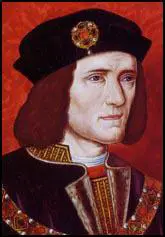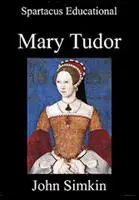Richard III

Richard, the eleventh child of Richard, Duke of York, and Cecily Neville, was born in 1452. In 1471 Richard married Anne Neville, the daughter of the earl of Warwick. When Edward IV died in 1483 his eldest son, Edward, was only twelve years old. It was therefore decided that Richard, Edward IV's brother, should became Protector of England, until Prince Edward was old enough to become king.
Elizabeth Woodville did not trust Richard and called for a Regency Council to run the country. Richard reacted by persuading Parliament that Edward IV had not been legally married to Elizabeth Woodville, and therefore Prince Edward was not the true heir to the throne. As Edward IV's only surviving brother, Richard claimed the throne for himself.
Richard had Prince Edward and his younger brother, Richard, taken into custody. Soon rumours began to circulate that Richard had arranged for his two nephews to be murdered. Opposition to Richard was led by the Lancastrian, Henry Tudor.
In August 1485, Henry Tudor arrived in Wales with 2, 000 of his supporters. He also brought with him over 2, 000 mercenaries recruited from French prisons. While in Wales, Henry also persuaded many skillful longbowmen to join him in his fight against Richard. By the time Henry Tudor reached England the size of his army had grown to 5,000 men.
When Richard heard about the arrival of Henry he marched his army to meet his rival for the throne. On the way, Richard tried to recruit as many men as possible to fight in his army, but by the time he reached Leicester he only had an army of 6,000 men. The earl of Northumberland also brought 3,000 men but his loyalty to Richard was in doubt.
Richard sent an order to Lord Thomas Stanley and Sir William Stanley, two of the most powerful men in England, to bring their 6,000 soldiers to fight for the king. Richard had been informed that Lord Stanley had already promised to help Henry Tudor. In order to persuade him to change his mind, Richard arranged for Lord Stanley's eldest son to be kidnapped.
On 21 August 1485, King Richard's army positioned themselves on Ambien Hill, close to the small village of Bosworth in Leicestershire. Henry arrived the next day and took up a position facing Richard. When the Stanley brothers arrived they did not join either of the two armies. Instead, Lord Stanley went to the north of the battlefield and Sir William to the south. The four armies now made up the four sides of a square.
Without the support of the Stanley brothers, Richard looked certain to be defeated. Richard therefore gave orders for Lord Stanley's son to be brought to the top of the hill. The king then sent a message to Lord Stanley threatening to execute his son unless he immediately sent his troops to join the king on Ambien Hill. Lord Stanley's reply was short: "Sire, I have other sons."
Henry Tudor's forces now charged King Richard's army. Although out-numbered, Richard's superior position at the top of the hill enabled him to stop the rival forces breaking through at first. When the situation began to deteriorate, Richard called up his reserve forces led by the earl of Northumberland. However, Northumberland, convinced that Richard was going to lose, ignored the order.
| Spartacus E-Books (Price £0.99 / $1.50) | ||||||
|---|---|---|---|---|---|---|
Richard's advisers told him that he must try to get away. Richard refused, claiming that he could still obtain victory by killing Henry Tudor. He argued that once the pretender to the throne was dead, his army would have no reason to go on fighting.
A few of his close friends agreed to accompany him on his mission. So that everyone knew who he was, Richard put on his crown. After choosing an axe as his weapon, Richard and a small group of men charged down the hill.
Henry's guards quickly surrounded their leader. Before Richard could get to Henry, he was knocked off his horse. Surrounded by the enemy, Richard continued to fight until he was killed.
Tradition has it that Richard's crown was found under a gorse bush. Lord Stanley, whose intervention had proved so important, was given the honour of crowning Henry VII the new king of England and Wales.
Primary Sources
(1) Dominic Mancini, The Usurpation of Richard III (c. 1483)
He (Edward V) and his brother were transferred to the inner chambers of the Tower. Every day their appearances behind the bars and windows grew less frequent and eventually they ceased to appear altogether... However, I have not yet been able to establish whether Edward was murdered.
(2) John Russell, The Croyland Chronicle (c. 1480)
On Friday, 13 June, Lord Hastings, on the orders of Richard, was beheaded. Two senior churchmen, Thomas, archbishop of York, and John, bishop of Ely, were spared capital punishment out of respect for their status, and they were taken as prisoners to different castles in Wales.





